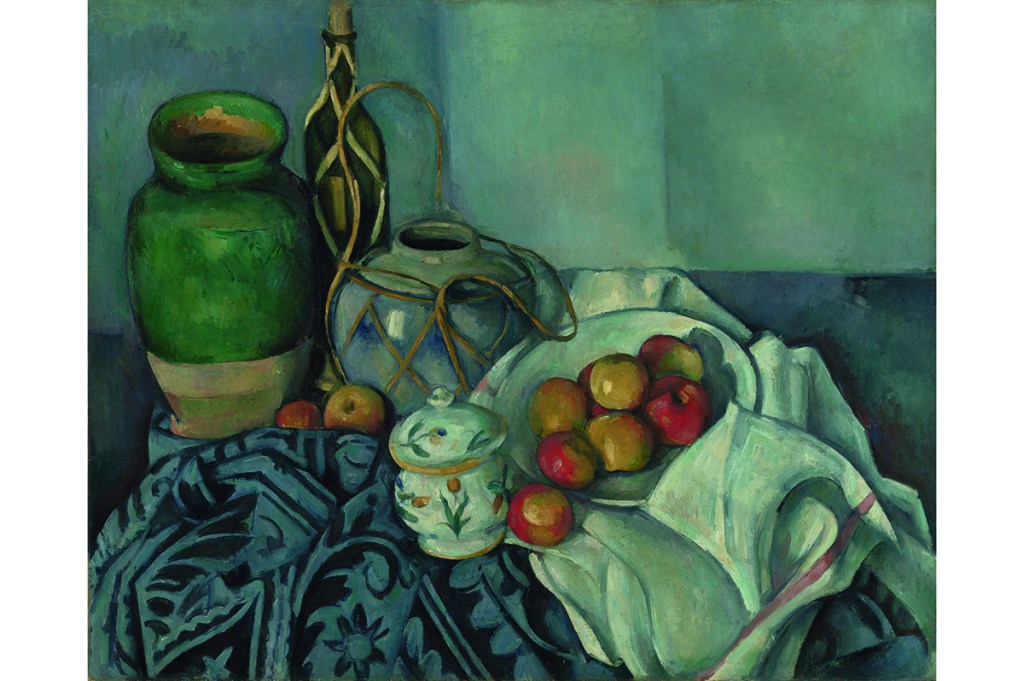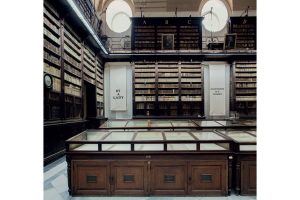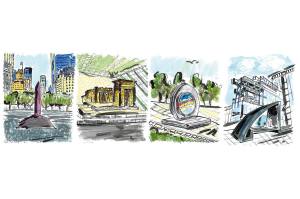Back in the fall of 1995, on the centennial of Paul Cezanne’s breakout late-career exhibition at Ambroise Vollard’s avant-garde art gallery, a retrospective opened at the Grand Palais in Paris, titled simply “Cézanne.” That show traveled to the Tate in London in 1996 and then to the Philadelphia Museum of Art. Now, more than a quarter century later, another retrospective with a similarly spartan title has opened in the Windy City: a joint venture between the Art Institute of Chicago and Tate Modern.
Cezanne, an exhibition curated by the AIC’s Gloria Groom and Caitlin Haskell as well as Tate Modern’s Natalia Sidlina, has us dropping the accent aigu, in keeping with the wishes of Société Paul Cezanne (the artist’s descendants now say this is truer to the original Provençal spelling). But there are other, more significant differences.
The current retrospective is smaller and doesn’t include some of the artist’s most iconic motifs — so no card players, no boy in red vest, no harlequins. The Philadelphia Museum’s epic “Large Bathers” (1900-06) is not in this show, and of Cezanne’s twenty-four surviving painted self-portraits, only one made its way to Chicago. But despite these absences, it’s worth keeping in mind that any major Cezanne exhibition is a happy event. And the current retrospective does have exceptional canvases on loan from international public and private collections, supplementing the Art Institute’s own substantial holdings.
Another important difference has to do with the exhibition display. This time around, curators have opted for a non-chronological layout. As Groom explains, “we wanted to do something that would focus on his technique and on the way he constructs a painting, and the way he moves from one subject to another…A lot of exhibitions since 1996 have taken on different aspects of his work and so we felt it was just time to put him back together again in the non-linear fashion that he himself developed.”
It’s true that Cezanne (1839-1906) followed a circuitous path. His paintings often fold back on each other, referencing and reshaping ideas that originally surfaced years or even decades before. He constantly alternated between working from the imagination and from direct observation. Paintings from life informed invented scenes, and vice versa. But looking back on his own career, Cezanne also recognized important trends and breakthroughs: “Until I was forty I lived the artist’s bohemian life; I threw away my life. It was only later, when I knew Pissarro, who worked tirelessly, that an appetite for work came to me.”
The Chicago retrospective opens with three spellbinding late landscapes, hung alongside two earlier landscapes from the 1870s. The later canvases were created by an artist firing on all cylinders, employing perfectly keyed color relationship and innovative, taut compositions reflecting an abstract awareness developed over years of focused, solitary work. The earlier pieces, though comparatively clumsy, disclose Cezanne’s outsized ambition (the influence of Courbet and Manet is obvious) and spark our interest in finding out for ourselves how he got from here to there.
Born in Aix-en-Provence, Cezanne first went to Paris to study art in 1861, where he worked with Camille Pissarro at the Académie Suisse. Pissarro recalled that Cezanne’s nudes from that year, with the paint slathered on in thick impastos, in what he called his manière couillarde, his “ballsy style,” earned snickers from classmates.
After bopping around Paris, Cezanne reconnected with Pissarro and began painting the landscape alongside him in 1872. Over the next half decade, Cezanne’s approach to painting transformed: his color grew more natural and impressionistic, his paint application more nuanced and subtle. His drawing also got better — less heavy-handed, more delicate and lyrical.
Yet despite these changes, the paintings lost none of their intensity and in many ways became more obsessively focused, especially after 1877. In thoroughly worked-over still lifes, landscapes and figurative works, Cezanne knitted clusters of slanting taches, or patch-like brushstrokes, into evocative tapestries of color. Excellent examples from the period are on display here in Chicago, many of which were once owned by other hugely important modernist painters. These include “Still Life with Apples,” (c. 1878), once owned by Degas; “Still Life with Fruit Dish” (1879-80), once owned by Gauguin; “The Sea at L’Estaque Behind Trees” (1878- 79), once owned by Picasso; and “Three Bathers” (1876-77), once owned by Matisse.
Indeed, exhibition organizers have gone out of their way to communicate Cezanne’s profound importance to other artists, then and now, highlighting the provenance of paintings collected by fellow practitioners in large font on the wall labels. Among Cezanne’s other collectors were Monet, Renoir, Henry Moore, Edward Steichen, Lucian Freud and Jasper Johns. Additionally, in what is quickly becoming a museological cliché, curators have commissioned ten contemporary artists to contribute “reflections” on Cezanne’s artworks, appearing both as gallery wall texts and in the exhibition’s catalogue. These musings take the form of poems, journal entries and essays, and are occasionally insightful.
During the 1880s, Cezanne worked both in Provence and in the countryside around Paris. Paintings from this decade are airier, made with a lighter touch, perhaps a result of the artist’s experiments with watercolor. A magnificent oil of a favorite motif, “Mont Sainte-Victoire with Large Pine” (c. 1887), on loan from London’s Courtauld Gallery, shows Cezanne drawing and painting simultaneously, with aesthetic maturity and painterly confidence.
From the 1890s until his death in 1906, Cezanne’s palette darkened, yet the hues became richer. In many, deep blues and emerald greens look like stained glass. In a letter from 1904, Cezanne connects these colors with his abiding interest in the natural world: “into our vibrations of light, represented by reds and yellows, we need to introduce sufficient blues to make one feel the air.” “The Smoker” (1890), “Large Bathers,” (c. 1894- 1905), several late still lifes, and above all a handful of towering Mont Sainte-Victoires show Cezanne scaling another kind of peak. Here, he’s at the top of his game.
Perhaps Cezanne’s genius was that, with time, he came to understand where his talents lay and then used those gifts to create masterpiece after masterpiece during the last twenty-five years of his life. Refused by the official salons, misunderstood by friends and family alike, Cezanne seems to have developed an inner compass which guided his mature work. Writing to a young painter in 1905, Cezanne shared some hard-won insights:
The Louvre is the book in which we learn to read. We must not, however, be satisfied with memorizing the attractive formulas of our predecessors. We must leave the museum to study Nature in all its beauty. We must try to grasp its spirit; we must seek to express ourselves according to our personal temperament.
The story of Cezanne’s long quest to do just this — to adequately express himself according to his own temperament — is essential to our understanding of his achievements. Those unfamiliar with Cezanne’s work may want to begin their visit to this retrospective by seeking out paintings made from the 1880s onward in order, before going through the show again, paying close attention to the dates on wall labels.
The primary task of a retrospective exhibition is to offer museumgoers a coherent sense for an artist’s lifelong project. It’s tempting to look for new ways to examine the impact of Cezanne — to shed new light, break new ground, especially for an artist as consistently exposed as the Provençal modernist master. Yet despite this curatorial impulse to reframe and reconsider, it’s still fine to let the paintings tell their own story. Indeed, at times it is essential. The Art Institute’s visitors, especially those encountering Cezanne’s astonishing artworks for the first time, deserve to see the works tell that story, in their own unobtrusive context, no matter how often it’s been told.
This article was originally published in The Spectator’s July 2022 World edition.


















